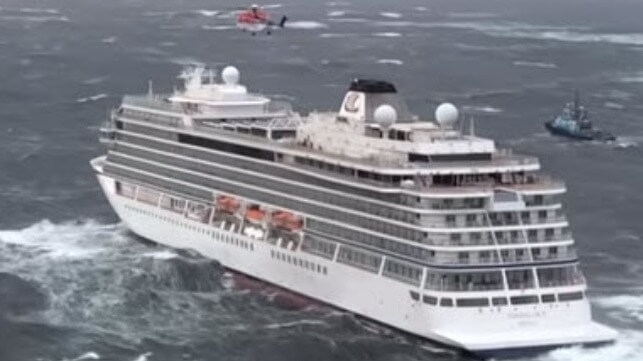Report Contends Viking Sky Was Non-Compliant and Should Not Have Sailed

Five years after Viking’s cruise ship Viking Sky blacked out during a storm and came within a ship’s length of a disastrous grounding, the Norwegian Safety Investigation Authority (NSIA) issued a highly critical report of the cruise line and the operational managers while also saying the design, shipyard, and classification society also have a role in the incident. The NSIA report agrees with the earlier finding of the Norwegian Maritime Authority (NMA) that the root cause was an insufficient level of oil in the ship’s tanks, but in disputed finding cites likely possible SOLAS violations, saying the ship should never have departed Tromso, Norway two days earlier.
The Viking Sky (47,800 gross tons) entered service in 2017 as one of the class of new Fincantieri-built cruise ships for Viking’s ocean cruise line. The two-year-old cruise ship departed Tromso on March 21, 2019, and two days later on the afternoon of March 23 blacked out with 1,374 people aboard losing all propulsion and steering while in a severe Norwegian coastal storm.
Conditions were too bad to evacuate the ship which drifted helplessly and nearly grounded in what NSIA calls an accident that “had the potential to develop into one of the worst disasters at sea in modern times.” The captain was able to maneuver the ship into deeper water when power was restored while more than 400 passengers were removed by helicopter. As many as 900 people remained aboard the ship, many with broken bones and injuries, while the Viking Sky eventually was able to limp into port
Both organizations agree the root cause of the accident was an insufficient amount of lubricating oil in all the vessel’s operating diesel generators’ lubricating oil sump tanks. In the rough seas with the ship pitching and rolling, the systems lost pressure causing the cruise ship to fully black out. It took 39 minutes until both propulsion motors were operational and the ship had sufficient power to maintain between 1 and 5 knots ahead.
In a 158-page report, NSIA identifies operational, technical, and organizational safety issues. They say all of this contributed to the black out citing Viking as well as Wilhelmsen Ship Management, Fincantieri, and Lloyd’s Register while calling on IMO and the International Association of Classification Societies to all take actions to reflect the experience of this incident to prevent it from happening again.
NSIA says the cruise ship should never have departed Tomso, citing the fact that one of its four diesel generators was unavailable exposing the passengers and crew to an increased risk. They allege the vessel did not have the redundancy required under the Safe Return to Port regulations, did not comply with applicable safety standards, and did not meet SOLAS regulations on issues such as the lube oil sump tank design. Further, the report says the design also did not meet the engine manufacturer’s recommendations.
“Insufficient training likely contributed to why the black out recovery was time consuming,” NSIA further contends in the report. They said while the engineers had conducted black out drills they never trained for a situation without an available standby generator.
The Norwegian Maritime Authority concurs with much of the report highlighting that they also identified the core issue of insufficient oil which caused the drop in pressure in its early investigation shortly after the incident. They however “respectfully disagree” with the contention the vessel did not comply with SOLAS regulations.
“As long as the ships have operated with a higher level of oil in the lubrication tanks, there have been no instances of a drop in oil pressure or blackout,” the NMA writes in its response. They argue the issue of the fourth generator being out of order is not applicable and even if it had been operational it likely would have also had a problem due to the overall oil deficiency.
NSIA issued a total of 14 safety recommendations based on its findings. They recommend Fincantieri review and strengthen the design process to ensure the lube oil sump tanks are in SOLAS compliance and that Lloyd’s Register review and strengthen its plan approval process. The shipowner and operator they recommend take action to ensure compliance with SOLAS and implement systematic and holistic reviews of the oil monitoring system. They also call on IMO and IACS to include technical guidance on the rules as they relate to the oil pressure issue that occurred.
No comments:
Post a Comment